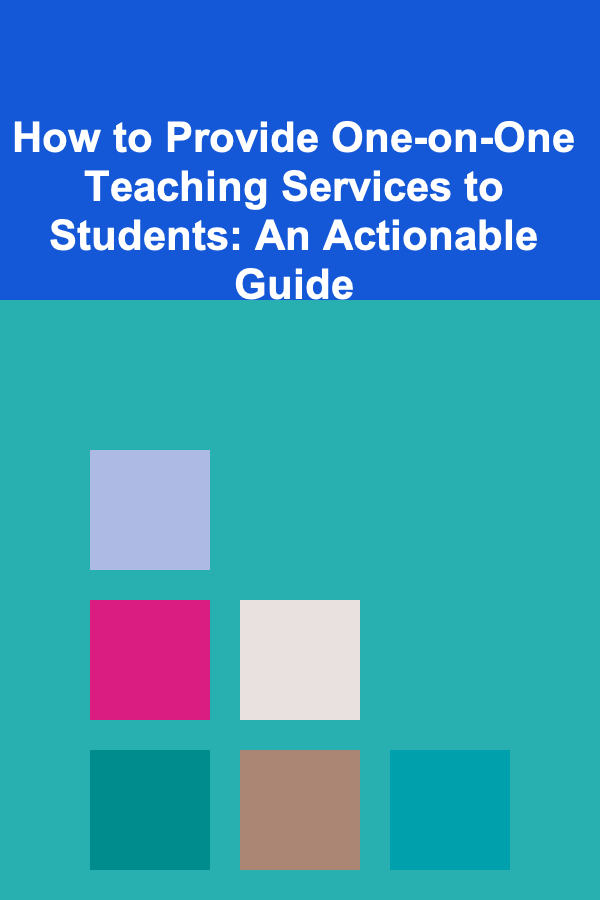
How to Provide One-on-One Teaching Services to Students: An Actionable Guide
ebook include PDF & Audio bundle (Micro Guide)
$12.99$8.99
Limited Time Offer! Order within the next:

Providing one-on-one teaching services is an incredibly rewarding and effective way to help students achieve their academic goals. Whether you're a tutor, a teacher, or a mentor, offering personalized, individualized attention allows you to tailor your teaching to each student's unique needs, learning style, and pace. In this actionable guide, we will explore the steps and best practices for providing one-on-one teaching services that foster growth, build confidence, and lead to success.
Understand the Student's Learning Style
Every student learns differently, and one of the key benefits of one-on-one teaching is the ability to tailor your approach to fit the student's specific learning style. By identifying how the student processes information, you can create a more engaging and effective learning experience.
Actionable Steps:
- Conduct an initial assessment: Before diving into lessons, take some time to learn about the student's preferred learning style. Do they respond best to visual aids, hands-on activities, auditory explanations, or reading and writing? Understanding these preferences will allow you to adapt your teaching methods accordingly.
- Ask questions to uncover challenges: Through open-ended questions, explore the areas where the student feels challenged or overwhelmed. This will not only help you understand their learning style but also pinpoint areas that require more focus.
- Observe how they engage: During the first few sessions, observe how the student engages with the material. Do they ask questions or seem distracted? Are they taking notes or drawing diagrams to visualize concepts? These behaviors can provide valuable insights into how they process information.
Set Clear Goals and Expectations
Setting clear, realistic goals and expectations is essential for both you and your student. Goals provide direction and motivation, while expectations create a structured environment that promotes discipline and focus. These goals should be both short-term and long-term, with measurable milestones to track progress.
Actionable Steps:
- Discuss long-term academic objectives: At the beginning of your tutoring relationship, talk to the student about their broader academic goals. Are they preparing for an exam, trying to improve in a specific subject, or simply looking to build foundational skills? Understanding these goals will help you design an appropriate teaching plan.
- Break down the learning journey: Once you understand their long-term goals, break them down into manageable short-term objectives. For example, if a student is preparing for a math exam, you could set weekly goals for mastering specific topics or solving a certain number of practice problems.
- Be flexible and adjust as needed: Learning is a dynamic process, and goals may need to be adjusted as the student progresses. Regularly check in on the student's development and make changes to your approach based on their performance and feedback.
Create a Personalized Learning Plan
A personalized learning plan ensures that your teaching is specifically suited to the student's needs. This plan should be dynamic and adaptable, with a clear structure that allows for flexibility based on the student's progress and evolving requirements.
Actionable Steps:
- Assess the student's strengths and weaknesses: Start by identifying what the student already knows and where they need improvement. This could involve reviewing past assignments, conducting diagnostic tests, or simply asking the student about the areas they find difficult.
- Tailor the curriculum: Based on the student's strengths, weaknesses, and learning style, design lessons that target specific areas of improvement. For example, if a student struggles with reading comprehension, you could plan activities like reading passages, asking comprehension questions, and discussing key themes.
- Incorporate variety: Vary the learning activities to maintain the student's interest and keep them engaged. This might include using multimedia resources, creating interactive exercises, or integrating real-world examples into the lessons.
Foster a Positive and Supportive Learning Environment
One-on-one teaching is as much about emotional and psychological support as it is about academic development. A positive, supportive environment can help students feel comfortable, reduce anxiety, and encourage them to take risks in their learning process.
Actionable Steps:
- Create a welcoming space: Whether teaching in person or online, ensure that the learning environment is welcoming and conducive to focus. This means minimizing distractions, having all necessary materials at hand, and ensuring the student feels comfortable asking questions.
- Encourage open communication: Let the student know that it's okay to make mistakes and that asking questions is encouraged. Create a safe space where they can express confusion or difficulty without feeling judged.
- Provide positive reinforcement: Celebrate successes, no matter how small. Acknowledge improvements, and provide constructive feedback in a way that motivates the student to continue. Positive reinforcement can significantly boost the student's confidence and encourage them to stay engaged in the learning process.
Utilize Interactive and Engaging Teaching Techniques
One-on-one teaching offers the flexibility to engage students in interactive activities that can make learning more enjoyable and memorable. Active learning methods are often more effective than passive methods like lecturing because they require students to actively engage with the material.
Actionable Steps:
- Incorporate hands-on activities: If possible, use physical materials or digital tools that allow students to actively participate in the learning process. For example, if teaching math, you could use manipulatives to help them visualize problems, or if teaching a language, you could engage in conversation practice.
- Ask guiding questions: Rather than simply giving answers, ask questions that prompt the student to think critically and problem-solve. This encourages deeper understanding and helps them internalize the material.
- Use technology: Incorporate educational apps, games, or online resources that can make learning more interactive. For example, using an online quiz platform to review vocabulary, or a simulation for science experiments, can bring a dynamic aspect to the lesson.
Provide Constructive Feedback and Continuous Improvement
Continuous feedback is crucial for student development. As a one-on-one tutor, you have the ability to provide immediate feedback, which allows the student to correct mistakes, deepen their understanding, and reinforce learning.
Actionable Steps:
- Offer specific, actionable feedback: Instead of just saying "Good job," provide feedback that outlines exactly what the student did well and where they need improvement. For example, "Your essay had great organization, but you need to improve your thesis statement to make it clearer."
- Encourage self-reflection: Help the student develop a habit of self-reflection by asking them to evaluate their own work. Questions like "What do you think you could improve on next time?" or "What part of the lesson was the hardest for you?" foster a growth mindset.
- Track progress: Regularly assess the student's progress against the goals you've set. This could be through quizzes, assignments, or simply through conversations about their understanding of the material. Tracking progress helps both you and the student stay focused and motivated.
Be Adaptable and Patient
Every student learns at their own pace, and the ability to be adaptable and patient is essential when providing one-on-one teaching services. Students may struggle with certain concepts or need more time to grasp certain ideas. Being patient and flexible allows you to provide the best possible learning experience for each student.
Actionable Steps:
- Adjust your pace based on the student's needs: If a student is struggling with a concept, slow down and take more time to explain it in different ways. Conversely, if the student is progressing faster than expected, challenge them with more advanced material or creative exercises.
- Recognize when to seek help: Sometimes, despite your best efforts, a student may not be responding to your teaching style. In these cases, consider seeking advice from a colleague, mentor, or educational specialist to help you adjust your approach.
- Practice patience: Learning is often a slow process, especially in one-on-one settings where progress can be more noticeable. Be patient with your student's learning curve and provide the emotional support needed to help them overcome obstacles.
Evaluate and Adjust Your Teaching Methods
Lastly, always reflect on your teaching methods and be open to change. Regular self-evaluation helps you stay effective as an educator and ensures that you continue meeting the student's evolving needs.
Actionable Steps:
- Ask for feedback: Encourage your student to provide feedback on your teaching style. Do they feel that they are improving? Are there areas where they need more help? Student feedback is invaluable in guiding your teaching methods.
- Continuously improve your skills: Stay updated on new teaching techniques, tools, and trends that can enhance your tutoring services. Attend workshops, read educational books, or participate in online forums to grow as a teacher.
- Reassess goals periodically: Revisit the goals you've set with your student every few weeks to ensure that you are on track. If the student has achieved certain milestones, it may be time to set new goals or shift focus to other areas.
Conclusion
Providing one-on-one teaching services is a dynamic and enriching experience that requires a blend of preparation, adaptability, and empathy. By understanding the student's learning style, setting clear goals, creating personalized plans, and fostering a supportive environment, you can help them succeed in a way that traditional classroom settings may not allow. The key is to remain flexible, provide continuous feedback, and always be willing to adjust your approach as needed. When done right, one-on-one teaching can significantly impact a student's academic journey, leading to both personal and intellectual growth.

How to Make Your Home Less Vulnerable to Security Threats
Read More
How to Manage Your Finances During a Career Transition
Read More
How to Store Fishing Nets Without Taking Up Space
Read More
Mastering Interior Design: Strategies for Creative and Practical Design Solutions
Read More
The Ultimate Guide to Thrifty Gardening Tips for Beginners
Read More
Using Deep Learning to Automate Income Generation
Read MoreOther Products

How to Make Your Home Less Vulnerable to Security Threats
Read More
How to Manage Your Finances During a Career Transition
Read More
How to Store Fishing Nets Without Taking Up Space
Read More
Mastering Interior Design: Strategies for Creative and Practical Design Solutions
Read More
The Ultimate Guide to Thrifty Gardening Tips for Beginners
Read More